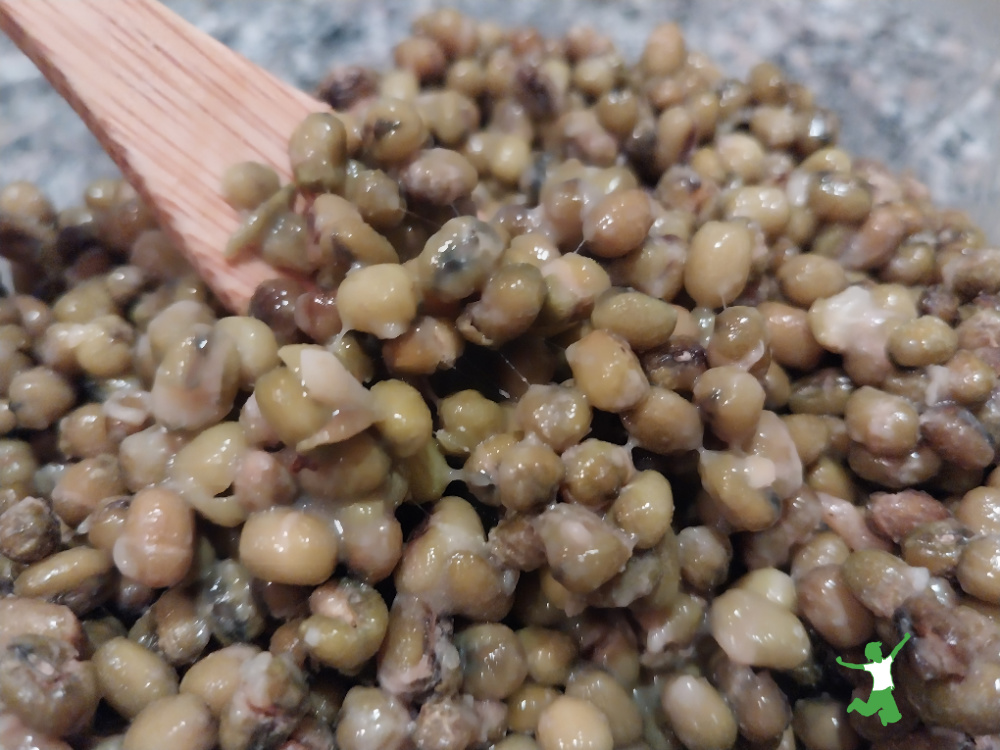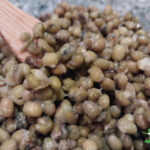Table of Contents[Hide][Show]
How to make soy-free natto at home easily and inexpensively that is rich in Vitamin K2 and therapeutic soil-based probiotics.

Natto is a critical traditional food to include in your diet, yet most traditional foodies ironically have never tried it.
Natto is a form of fermented soy and is one of the few (only?) cultured foods that contains a beneficial, soil-based bacterium.
In the case of natto, it is the powerful gut cleanup crew known as Bacillus subtlis.
Tempeh and miso also contain soil-based microbes, but they are the molds Rhizopus orzae and Aspergillus oryzae, respectively, which can cause allergic issues for some people.
Kefir made with live grains (not powder starter) contains dozens of strains of beneficial bacteria and candida-busting yeasts. Surprisingly, none of these strains are soil-based according to my research.
Thus, it may come as a surprise that eating a variety of fermented foods but excluding natto will likely leave a huge gap in your probiotic experience.
Soil-based bacteria are very important for gut restoration (aka, healing leaky gut) as well as optimal intestinal maintenance.
For example, those on the GAPS diet will likely plateau in their healing journey if they don’t either eat natto or take a therapeutic SBO probiotic (I suggest this brand).
Since SBO probiotics are some of the most expensive on the market, it is a good idea to make natto yourself.
You will save a bundle!
I actually love the taste of natto and eat 1-3 tablespoons of my homemade soy-free versions most days.
Word to the wise…natto is definitely an acquired taste! Most people do not like it at first!
The slimy texture takes some getting used to also. The experience of natto on the tongue is not a common sensation in Western dishes!
I prefer to eat soy-free natto made from fermented mung beans (you can use other types of legumes if desired).
Mung bean natto visually and texturally best mimics premium small soybean organic natto…at least to my palate!
If you wish to eat natto regularly like I do, using a legume other than soy is wise. Many people do not realize that soy is still thyroid suppressing even if fermented.
Bonus! Natto not only contains elusive soil based organisms (SBOs). It also contains more Vitamin K2 than any other food!
Wait, there’s more!
Eating natto provides the body with ample amounts of the important enzyme nattokinase, which has numerous health benefits and is useful for naturally treating a wide variety of conditions. (1)
Only 2 tablespoons of natto contains roughly 220 mcg of MK-7 (the fermented form of Vitamin K2).
So making your own natto and eating it regularly may permit you to forgo Vitamin K2 supplements as well.
Preparation Tip
I do not recommend making natto with any type of sprouted legume.
The results turn out mushy!
The consistency and texture of soy-free natto turn out the best when you soak your unsprouted legume of choice overnight, cook until just soft, and then initiate the fermentation process while the beans are still warm.

Homemade Soy-free Natto
How to make natto at home easily and inexpensively with mung beans instead of estrogenic soybeans.
Ingredients
- 1 cup dried mung beans unsprouted and organic
- filtered water
- 1 packet natto spores
Instructions
-
Rinse mung beans and place them in a large glass bowl. Cover with enough filtered water to allow the beans to roughly double in size as they expand. Leave on the counter for 8 hours or overnight.
-
Drain the soaking water and place beans in a large pot. Cover with fresh filtered water.
-
Bring the beans to a boil, turn down the temperature to a simmer, affix the lid and cook the beans for about 20 minutes until just soft but not mushy (do not overcook!).
-
Drain the beans and place in a large VitaClay slow cooker or crockpot. The beans should be no more than 1" in depth. Discard any beans that may accidentally spill during the transfer from the pot to a VitaClay (or other slow cooker).
-
Let the beans cool for 10 minutes in the Vitaclay.
-
While the beans are cooling slightly, dissolve a packet of natto starter in 3 Tbsp of warm filtered water.
-
Pour the natto spore solution over the cooled but still warm beans. Stir gently to mix with a clean, bamboo spoon.
-
Place the lid on the VitaClay and select the "yogurt" setting.
If using a different type of slow cooker, use the setting that will keep the beans between 100-110 °F/ 38-43 °C which is the temperature range necessary to ferment the beans into natto.
-
After 24 hours, turn off the Vitaclay, remove the lid, and cool the natto to room temperature for 1 hour. A whitish film and an ammonia-like aroma means they are done. The beans will also have a stringy and slimy appearance (see photo above).
-
Place the cooled natto in a glass container with a tight-fitting lid and refrigerate.
-
Natto will be ready to eat once refrigerated overnight. It will last for months, and the flavor will age and strengthen with time.
-
Mung beans contain less than 1% of the isoflavones in soy. Thus, feel free to eat 1-3 tablespoons per day of mung bean natto for an inexpensive and tasty soil-based probiotic and Vitamin K2 food source.

(1) Health Benefits of Natto








Would natto with chickpeas also deliver vitamin K2?
Yes they would if properly made with the correct starter.
FYI: Your link to the mung beans on amazon to order – is actually SOYBEANS. That’s disappointing.
The link in the recipe is correct for the mung beans I use to make the soy-free natto.
You must have gotten confused as I linked to a soybean natto that I like as well in the body of the article.
The sentence reads “Mung bean natto visually and texturally best mimics premium small soybean organic natto…at least to my palate!”
I was comparing mung beans to the best quality soybean natto. Link is correct.
Would you recommend subbing in organic lentils to make the Natto recipe? They are so much easier to find.
I haven’t tried them, but it would probably work fine.
I just had a thought, could I make this natto recipe with a grain like Sorghum ?
You are welcome to try it. Natto is best made from legumes, not grains though.
Unfortunately, I am reacting to the mung bean so I cannot eat this.
Sarah, do you know if there are any Gluten – Free and ,ALSO, Lectin-Free legumes which could be used to make this natto ? They also should not be thyroid suppressing.
Thanks !
The only grains I can eat that I know of are sorghum and millet (but I stay away from millet because it is thyroid suppressing) and I would like to try teff and fonio but I have not yet done so. I have no idea who sells fonio, it does not look like you can get it here in the US.
I haven’t tried anything but mung beans at this point which most closely mimics traditional soy natto in my opinion, so any other ones you try is up to you.